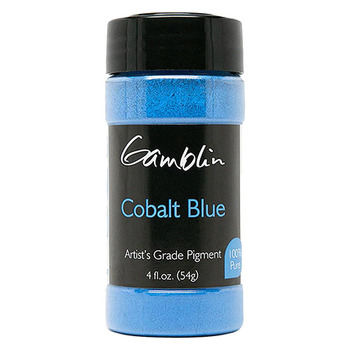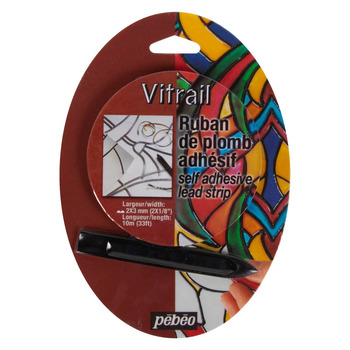Your Cart
SLI Search Template
Related Categories: Bright | Black Light Paint | Water Soluble | Permanent Alizarin Crimson | Ink Pens | Cadmium Scarlet | Transparent Oil Colors | Prussian Blue Watercolor Paint
-

 Gamblin Dry Pigment - Cobalt Blue, 54 GramsSave Up to25%Off listBlue 100% Pure Pigments With No Impurities With Gamblin's collection of 100% pure ground pigments, you can make your own unique paints. Gamblin uses these same pigments to make their famous Artist's Oil Colors. Each batch is finely ground so that you can bring out the pigment's full potential. Free of adulterants and impurities, Gamblin Pigments offer excellent value. Use them to create oil, acrylic, watercolor, and encaustic paints. Simply hand mix the dry pigment with the medium of your choice and start painting. Each color mixture retains the undertone and tinting strength of the included pigments. Dry pigments can also be used for a variety of DIY tasks. Mix with epoxy resin to fill resin molds or add a colored coating to a tabletop. You can also combine dry pigment with grout for mosaic and tile projects. Key Features: * Professional artist quality pigments * 100% pure with no additives or impurities * Finely-ground to make mixing easier * Mixture retains the tinting strength, undertone, and texture of the pigment Perfect For: * Making your own paints with the appropriate binder * Oils, acrylics, watercolors, egg tempera, cold wax, and encaustic * A wide variety of DIY projects * Coloring epoxy resin and grout Please protect yourself when handling powdered pigments. Pigments can be harmful in their powder form, especially to the lungs, if you breathe them in. It's important to wear a quality mask or respirator, gloves, and protective eyewear when working with pigments. See More
Gamblin Dry Pigment - Cobalt Blue, 54 GramsSave Up to25%Off listBlue 100% Pure Pigments With No Impurities With Gamblin's collection of 100% pure ground pigments, you can make your own unique paints. Gamblin uses these same pigments to make their famous Artist's Oil Colors. Each batch is finely ground so that you can bring out the pigment's full potential. Free of adulterants and impurities, Gamblin Pigments offer excellent value. Use them to create oil, acrylic, watercolor, and encaustic paints. Simply hand mix the dry pigment with the medium of your choice and start painting. Each color mixture retains the undertone and tinting strength of the included pigments. Dry pigments can also be used for a variety of DIY tasks. Mix with epoxy resin to fill resin molds or add a colored coating to a tabletop. You can also combine dry pigment with grout for mosaic and tile projects. Key Features: * Professional artist quality pigments * 100% pure with no additives or impurities * Finely-ground to make mixing easier * Mixture retains the tinting strength, undertone, and texture of the pigment Perfect For: * Making your own paints with the appropriate binder * Oils, acrylics, watercolors, egg tempera, cold wax, and encaustic * A wide variety of DIY projects * Coloring epoxy resin and grout Please protect yourself when handling powdered pigments. Pigments can be harmful in their powder form, especially to the lungs, if you breathe them in. It's important to wear a quality mask or respirator, gloves, and protective eyewear when working with pigments. See More -

 Pebeo Self-Adhesive Lead StripSave Up to38%Off listCreate The Beauty of Stained Glass with Vitrail Colors Luminous, high-gloss colors in transparent and opaque finishes great for glass, acetate, polyester, plexiglass! Pebeo Mixed Media Vitrail Colors are high-gloss, solvent-based colors, 36 total colors: available in 26 transparent and 10 opaque… Create The Beauty of Stained Glass with Vitrail Colors Luminous, high-gloss colors in transparent and opaque finishes great for glass, acetate, polyester, plexiglass! Pebeo Mixed Media Vitrail Colors are high-gloss, solvent-based colors, 36 total colors: available in 26 transparent and 10 opaque colors. These colors can be used with liquid art panels, metal, glass, ceramics, plastics, paper, canvas and more! Applied in thin or thick layers with a brush or used with a dropper. To imitate stained glass, use the Vitrail colours with the Cerne Relief outliners Key Features:* Mixable* Ready to use* Good lightfastness* Solvent-based* Transparent, intense and very bright colour* Opaque effect, luminous colours Perfect For:* Mixed media artists* Use on multiple surfaces* Use over acrylic mediums or in combination with resins What is Pebeo Vitrail Paint? To imitate a stained glass effect, use Vitrail Glass Paint with Pebeo Cerne Relief. Pebeo Cerne Relief is a water-based outliner that comes in a tube with a fine nozzle. It is available in a range of 7 colours and is used to create the outline of the design before applying the glass paint. After applying the Cerne Relief outliners, how long do you wait before applying Vitrail colours? It is better to allow the Cerne Relief dry at least 30 minutes prior to applying the Vitrail colours. QUALITY: Transparent, intense and very bright colours. Opaque effect, luminous colours. Solvent based, ready to use. Good lightfastness. Use with the cerne relief. COLOUR MIXABILITY: Colours can be mixed together. DRYING: 1 hour to the touch, completely dry after 8 hours. Drying times can vary depending on the thickness of the application, and the temperature and humidity of the room where the product is applied. SURFACES: Glass, polyester, acetate THINNER: Odorless mineral spirits or white spirits. OPACITY:Transparent and opaque colours FINISH Brilliant. See More
Pebeo Self-Adhesive Lead StripSave Up to38%Off listCreate The Beauty of Stained Glass with Vitrail Colors Luminous, high-gloss colors in transparent and opaque finishes great for glass, acetate, polyester, plexiglass! Pebeo Mixed Media Vitrail Colors are high-gloss, solvent-based colors, 36 total colors: available in 26 transparent and 10 opaque… Create The Beauty of Stained Glass with Vitrail Colors Luminous, high-gloss colors in transparent and opaque finishes great for glass, acetate, polyester, plexiglass! Pebeo Mixed Media Vitrail Colors are high-gloss, solvent-based colors, 36 total colors: available in 26 transparent and 10 opaque colors. These colors can be used with liquid art panels, metal, glass, ceramics, plastics, paper, canvas and more! Applied in thin or thick layers with a brush or used with a dropper. To imitate stained glass, use the Vitrail colours with the Cerne Relief outliners Key Features:* Mixable* Ready to use* Good lightfastness* Solvent-based* Transparent, intense and very bright colour* Opaque effect, luminous colours Perfect For:* Mixed media artists* Use on multiple surfaces* Use over acrylic mediums or in combination with resins What is Pebeo Vitrail Paint? To imitate a stained glass effect, use Vitrail Glass Paint with Pebeo Cerne Relief. Pebeo Cerne Relief is a water-based outliner that comes in a tube with a fine nozzle. It is available in a range of 7 colours and is used to create the outline of the design before applying the glass paint. After applying the Cerne Relief outliners, how long do you wait before applying Vitrail colours? It is better to allow the Cerne Relief dry at least 30 minutes prior to applying the Vitrail colours. QUALITY: Transparent, intense and very bright colours. Opaque effect, luminous colours. Solvent based, ready to use. Good lightfastness. Use with the cerne relief. COLOUR MIXABILITY: Colours can be mixed together. DRYING: 1 hour to the touch, completely dry after 8 hours. Drying times can vary depending on the thickness of the application, and the temperature and humidity of the room where the product is applied. SURFACES: Glass, polyester, acetate THINNER: Odorless mineral spirits or white spirits. OPACITY:Transparent and opaque colours FINISH Brilliant. See More -

 Old Holland Raw Materials Copal Resin 95gSave Up to40%Off list…Chemical compounds from chemical elements other than carbons (non-living). Some examples divided into three subgroups:Earth pigments: Ochres, Umbers, Green Earth, Caput Mortuum, Venetian Red. Mineral pigments: Malachite, Vermillion, Lapis Lazuli. Synthetic inorganic pigments (do not occur in nature… Prepare custom paints and base liquids with these pure, light-fast pigments and high quality raw materials! For the artists who prefer to create their own paints, Old Holland Classic Pigments and Raw Materials offers a carefully selected range of 98 light-fast dry pigments. Old Hollands organic, anorganic and synthetic organic pigments have outstanding color strength, clarity and intensity. Six different raw materials, from dammar resin to hide glue, allow artists and restorers to create their own base liquids. Old Holland uses these pigments to make all its paints. The pigments have an outstanding colour strength, clarity and brilliance Key Features: * Wide range of light-fast pure pigments * 98 light-fast dry pigments * Excellent color strength, clarity and brilliance * Organic pigments include Carmine, Indian Yellow and Madder Lacquer * Anorganic pigments include Umbers, Cadmiums and mineral pigments Perfect For: * Artists who prefer to create their own paints * Artists working in oils * Restoration work * Painting on canvas pigments can be divided into three groups: Group 1: Organic pigments Of natural origin, animal or vegetable (living), usually carbon compounds. Some examples: Carmine (from the Cochineal insect), Gummigutta, Gamboge (from the gum resin of the Garcinia Tree), Indian Yellow (from the urine of cows that eat mango leaves), Mummy (from the remains of Egyptian mummies), Madder Lacquer (from the root of the common Madder plant). Group 2: Anorganic pigments: Chemical compounds from chemical elements other than carbons (non-living). Some examples divided into three subgroups:Earth pigments: Ochres, Umbers, Green Earth, Caput Mortuum, Venetian Red. Mineral pigments: Malachite, Vermillion, Lapis Lazuli. Synthetic inorganic pigments (do not occur in nature but are manufactured): Prussian Blue, Ceruleum Blue, Lead White, Cadmiums. Group 3: Synthetic organic pigmentsComplex carbon compounds which do not occur in nature, but are created in the laboratory. Some examples: Phtalocyanine Blues and Greens, Quinacridones, Isoindolinones, Dioxazine, Azo Pigments. See More
Old Holland Raw Materials Copal Resin 95gSave Up to40%Off list…Chemical compounds from chemical elements other than carbons (non-living). Some examples divided into three subgroups:Earth pigments: Ochres, Umbers, Green Earth, Caput Mortuum, Venetian Red. Mineral pigments: Malachite, Vermillion, Lapis Lazuli. Synthetic inorganic pigments (do not occur in nature… Prepare custom paints and base liquids with these pure, light-fast pigments and high quality raw materials! For the artists who prefer to create their own paints, Old Holland Classic Pigments and Raw Materials offers a carefully selected range of 98 light-fast dry pigments. Old Hollands organic, anorganic and synthetic organic pigments have outstanding color strength, clarity and intensity. Six different raw materials, from dammar resin to hide glue, allow artists and restorers to create their own base liquids. Old Holland uses these pigments to make all its paints. The pigments have an outstanding colour strength, clarity and brilliance Key Features: * Wide range of light-fast pure pigments * 98 light-fast dry pigments * Excellent color strength, clarity and brilliance * Organic pigments include Carmine, Indian Yellow and Madder Lacquer * Anorganic pigments include Umbers, Cadmiums and mineral pigments Perfect For: * Artists who prefer to create their own paints * Artists working in oils * Restoration work * Painting on canvas pigments can be divided into three groups: Group 1: Organic pigments Of natural origin, animal or vegetable (living), usually carbon compounds. Some examples: Carmine (from the Cochineal insect), Gummigutta, Gamboge (from the gum resin of the Garcinia Tree), Indian Yellow (from the urine of cows that eat mango leaves), Mummy (from the remains of Egyptian mummies), Madder Lacquer (from the root of the common Madder plant). Group 2: Anorganic pigments: Chemical compounds from chemical elements other than carbons (non-living). Some examples divided into three subgroups:Earth pigments: Ochres, Umbers, Green Earth, Caput Mortuum, Venetian Red. Mineral pigments: Malachite, Vermillion, Lapis Lazuli. Synthetic inorganic pigments (do not occur in nature but are manufactured): Prussian Blue, Ceruleum Blue, Lead White, Cadmiums. Group 3: Synthetic organic pigmentsComplex carbon compounds which do not occur in nature, but are created in the laboratory. Some examples: Phtalocyanine Blues and Greens, Quinacridones, Isoindolinones, Dioxazine, Azo Pigments. See More
Powered by












Login and Registration Form
Customer Login
Already a customer ? Sign in now for the best experience!
* indicates a required field